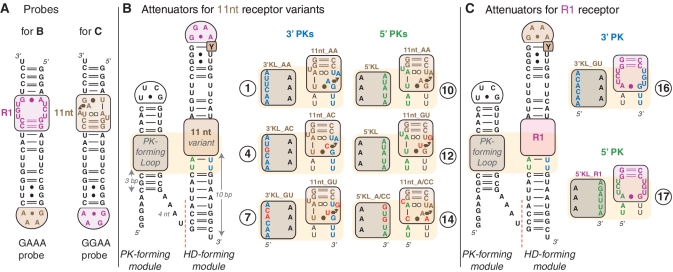Figure 2.
Secondary structure diagrams and nomenclature of tectoRNA attenuators reported. (A) GAAA and GGAA molecular probes. (B) TectoRNA attenuators based on 11 nt receptor variants: their HD-forming module can assemble with the GAAA probe. (C) TectoRNA attenuators based on the R1 receptor motif and assembling with the GGAA probe. Indicated RNA constructs (labeled 1–17) are those with combinations of PK-forming modules and HD-forming modules that can form 3′PK (between nucleotides in blue) or 5′PK (between nucleotides in green). Red nucleotides are positions that vary from molecules 1 and 10 (with the classic 11 nt receptor and corresponding 3′ and 5′ PK-forming loops). Most constructs tested have a U at the pyrimidine position, which is labeled ‘Y’ within the HD-forming module. Additional constructs with combinations of PK-forming modules and HD-forming modules leading to mismatched PKs or with Y = C have been tested (see Figures 3 and 5 and Supplementary Table S1). Base-pairings are indicated according to Leontis and Westhof (43) annotation. The 11nt_GU receptor has been reported in previous studies as receptor C7.10 (8,15). For a description of the modularity of 11 nt receptor variants, see Supplementary Figure S2.

